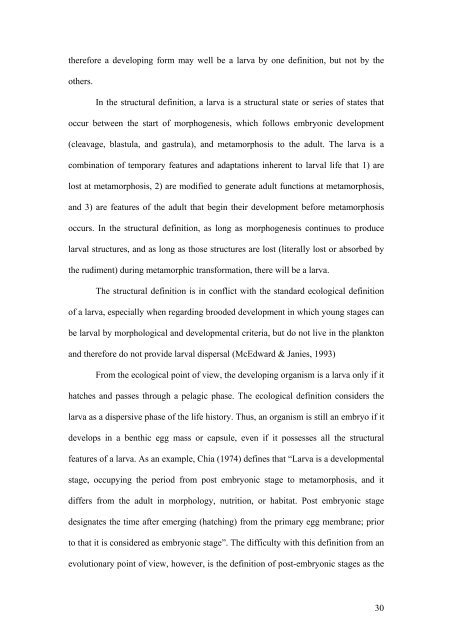Download (3398Kb) - ePrints Soton - University of Southampton
Download (3398Kb) - ePrints Soton - University of Southampton
Download (3398Kb) - ePrints Soton - University of Southampton
You also want an ePaper? Increase the reach of your titles
YUMPU automatically turns print PDFs into web optimized ePapers that Google loves.
therefore a developing form may well be a larva by one definition, but not by the<br />
others.<br />
In the structural definition, a larva is a structural state or series <strong>of</strong> states that<br />
occur between the start <strong>of</strong> morphogenesis, which follows embryonic development<br />
(cleavage, blastula, and gastrula), and metamorphosis to the adult. The larva is a<br />
combination <strong>of</strong> temporary features and adaptations inherent to larval life that 1) are<br />
lost at metamorphosis, 2) are modified to generate adult functions at metamorphosis,<br />
and 3) are features <strong>of</strong> the adult that begin their development before metamorphosis<br />
occurs. In the structural definition, as long as morphogenesis continues to produce<br />
larval structures, and as long as those structures are lost (literally lost or absorbed by<br />
the rudiment) during metamorphic transformation, there will be a larva.<br />
The structural definition is in conflict with the standard ecological definition<br />
<strong>of</strong> a larva, especially when regarding brooded development in which young stages can<br />
be larval by morphological and developmental criteria, but do not live in the plankton<br />
and therefore do not provide larval dispersal (McEdward & Janies, 1993)<br />
From the ecological point <strong>of</strong> view, the developing organism is a larva only if it<br />
hatches and passes through a pelagic phase. The ecological definition considers the<br />
larva as a dispersive phase <strong>of</strong> the life history. Thus, an organism is still an embryo if it<br />
develops in a benthic egg mass or capsule, even if it possesses all the structural<br />
features <strong>of</strong> a larva. As an example, Chia (1974) defines that “Larva is a developmental<br />
stage, occupying the period from post embryonic stage to metamorphosis, and it<br />
differs from the adult in morphology, nutrition, or habitat. Post embryonic stage<br />
designates the time after emerging (hatching) from the primary egg membrane; prior<br />
to that it is considered as embryonic stage”. The difficulty with this definition from an<br />
evolutionary point <strong>of</strong> view, however, is the definition <strong>of</strong> post-embryonic stages as the<br />
30
















